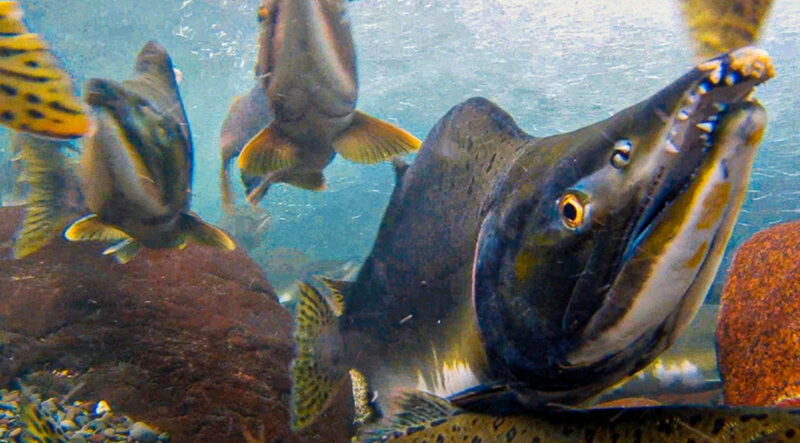Pink Salmon boom has nothing to do with fish farm closures
World-wide abundance of Pink Salmon being used by activists to push false narratives about aquaculture in British Columbia
By Fabian Dawson
SeaWestNews
Anti-fish farming activists are using the world-wide abundance of Pink Salmon to push false narratives that the high returns – also being recorded in British Columbia – are due to closures of open-net aquaculture operations on Canada’s west coast.
Cherry-picking data to confuse the public and hog the headlines, the activists are ignoring the fact that Pink Salmon are booming everywhere regardless of whether salmon farms are active or not.
“These claims that high Pink Salmon returns are due to the removal of salmon farms are the latest in a series of incorrect conclusions based on false assumptions from someone with an anti-salmon farming agenda,” said Michelle Franze, a spokesperson for the BC Salmon Farmers Association (BCSFA)
Pink Salmon, also referred to as Humpback Salmon, are booming all over the Pacific Ocean and have expanded their range into the Atlantic Ocean, reaching Norway, the UK and Newfoundland. Alaska and Russia are also dealing with massive runs of pink salmon.
Due to the “abundance” of Pink Salmon being caught in marine test fisheries, the Pacific Salmon Commission has increased its projections of Pink Salmon returns to the Fraser River to as high as 11.6 million, from an original estimate of between 6.1 million and 8.6 million fish.
“This trend isn’t new – Pink Salmon have been increasing in population and range for 50 years – with the Pacific Ocean now seeing the highest abundance of salmon since records began,” said Franze.
Among those using the abundance data to influence negative political and public opinions of salmon farming is activist Alexandra Morton, whom the Federal Court has said peddles in presenting “improper opinion evidence under the guise of being factual evidence.”
BC salmon farmers have been correcting the same claims made by Alexandra Morton and other anti-salmon farming activists for years, and BCSFA responded to the same pink salmon claim made last year.
“This constant spread of misinformation has cost taxpayers millions of dollars and has gone beyond being misguided and wrong,” said Franze.
Ian Roberts, chair of the Canadian Aquaculture Industry Alliance (CAIA) said since records have been kept, the Pacific Ocean has never hosted as many salmon as today as climate change pushes water temperatures to record highs.
“Most other salmon species don’t fare well in warmer waters, so they’ve ventured further into the northern hemisphere seeking cooler waters and food, leaving southern ranges for Pinks to dominate,” he said,
Roberts said claims by activists to support their theory that closing salmon farms influenced Pink Salmon returns this year are not supported by any evidence.
The claim that this year’s returning adult pinks, that left the Fraser River as small juveniles in the spring of 2022 and did not have sea lice, does not represent data collected by professional biologists, said Roberts.
“All populations of salmon, small and large, have some level of sea lice as it’s a natural part of the ocean ecosystem. Annual surveys confirm that sea lice prevalence on wild Pink Salmon in areas where salmon farms were removed was similar to previous years when farms were operating– no significant change in sea lice,” said Roberts, who is also director of communications for Mowi.
“The claim that these returning Pinks didn’t have to go pass fish farms is also false,” he said.
“Between Campbell River and Port Hardy, Mowi (one of three salmon companies farming in the area) had 10 salmon farms in operation during the spring outmigration in 2022.”
Roberts said odd-year pink salmon returns to the Fraser River have been above the average return nine times since salmon farming in British Columbia began at a commercial scale in 1988.
Since 1963, the largest returns (exceeding 20M) of Pink Salmon to the Fraser River have occurred during salmon farming activity: in 1991, 2001, 2003, 2009 and 2011. This year’s estimated return of 11.6M Pink Salmon to the Fraser River is in line with the 60-year average.
“The Pink Salmon’s success has nothing to do with local influences and everything to do with global ocean conditions.”
The latest fearmongering campaign being used by the anti-aquaculture lobby comes as the Federal Government works on Transition Plan for BC’s aquaculture industry that will impact more than 4,700 jobs mainly in indigenous and non-indigenous coastal communities and $1.2 billion in economic activity annually.
A decision on how to move forward with the Transition Plan is expected next year after further consultations with First Nations, coastal communities, stakeholders and the salmon farming industry.
About 40 percent of the BC in-ocean salmon farming sector has already been closed, despite DFO scientists and court rulings stating that the salmon farms in BC pose less than a minimal risk to wild stocks.
Much of these closures did not take into account the devastating economic impacts to aquaculture-dependent coastal communities and rights of First Nations, who see ocean-based farming as an economic life in remote areas where jobs are scarce.
There are now several legal challenges mounted by First Nations, aquaculture service and supply companies, and salmon farmers, over the decisions to shut down fish farms in British Columbia’s Discovery Islands.
Pink Salmon Photo courtesy DFO

